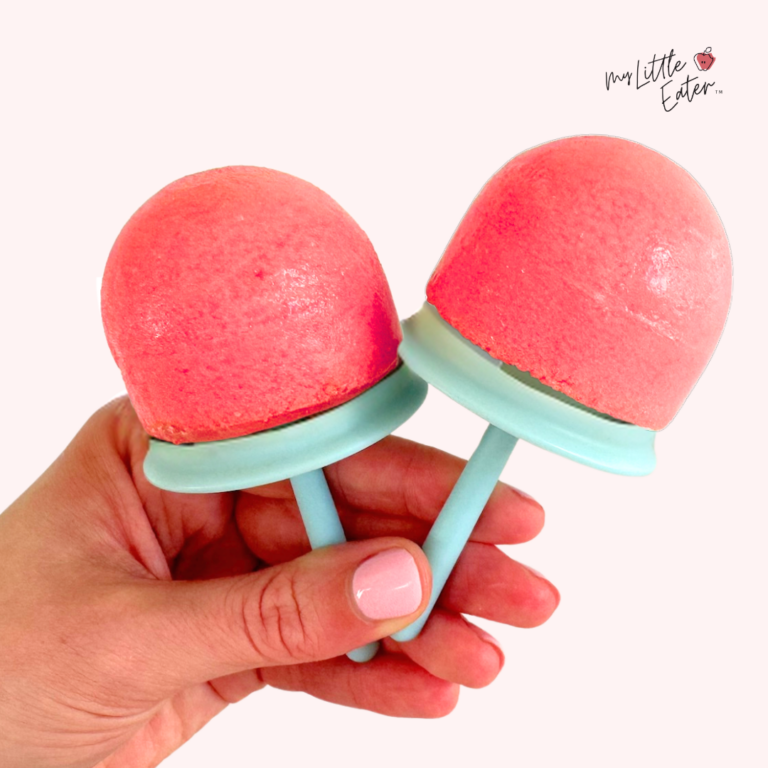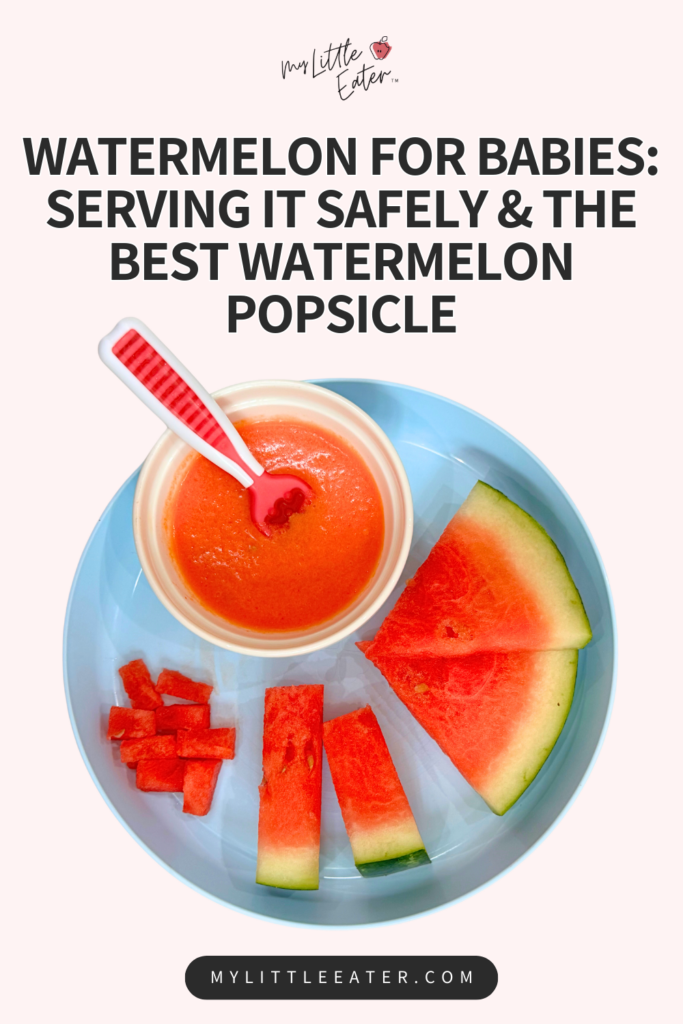- No Comments
- Chelsey Landry, RD, & Mallory Roberts, SLP
This post may contain affiliate links, please view our disclosure policy for more details.
Watermelon is a refreshing fruit perfect for any hot summer day! Packed with hydration and nutrients, watermelon offers a sweet taste that your little one will love. Whether you’re at the beach, the park, or cooling off at home – seedless watermelon makes the perfect summer snack!
Now, you may have questions about safely introducing watermelon to your baby for the first time, but don’t worry – we’ve got you covered!
We’ll be exploring the benefits of watermelon for babies, and offering tips on how to prepare and serve it safely. By following these tips, you can confidently offer this refreshing fruit to your baby all summer long!
Table of Contents
For ultimate confidence in how to feed your baby from 6-11 months of age, join our Baby Led Feeding online course! This expert-led, video-based course teaches you all about starting solids with the feeding method that’s best for you and your baby. You’ll learn how to progress through a variety of textures in a timely way, prevent picky eating, serve all food safely, and raise a food-loving baby!
And now it includes our Texture Timeline™ video library! Easily search for any food and find a video for exactly how to serve it according to age and phase. We’re continuously adding to this video library, and you’ll get lifetime access to it through the course!
When can babies eat watermelon?
Watermelon can be introduced to your baby when they start solids at around 6 months of age.
We recommend ensuring your baby shows all the developmental signs of readiness before introducing solids for the first time. But there’s no reason why seedless watermelon couldn’t be one of their first foods – if you wanted it too!

Is watermelon a choking hazard for babies?
Watermelon isn’t considered a common choking hazard for babies and toddlers. However, watermelon typically contains either white or black seeds.
The larger black seeds found in watermelon do pose a choking risk for babies. The white seeds aren’t considered to be a high choking risk, but it will be difficult for your little one to control or spit out the seeds.
It’s ideal to first remove all seeds, if possible, before serving – or purchase seedless watermelon (even still, we recommend checking before serving to be safe!).

Be prepared for some coughing and gagging when you first offer watermelon to your baby. Since it’s a mixed texture of solid and liquid, it will move around differently than solid-only foods in your baby’s mouth – but it’s still totally safe!
They’ll likely need some practice to get used to this new, mixed consistency and with time you should notice the gagging decrease.
Preparing watermelon for babies
Choosing a ripe watermelon
The first step in preparing watermelon for your baby is picking the perfect one!
You know…the one that’s the perfect shade of pink, without any seeds, has that perfect crunch and just the right amount of juiciness when you bite into it.

Since the edible part of the watermelon isn’t visible, you can follow these steps for picking the perfect watermelon for babies (1):
- Look the watermelon over. You’re looking for a firm, symmetrical watermelon that is free from bruises, cuts, or dents.
- Lift the watermelon. It should be heavy for its size. Watermelon is 92% water, so most of the weight is water!
- Turn it over. The underside of the watermelon should have a creamy yellow spot from where it sat on the ground.
Once you’ve found the perfect watermelon, it’s time for the next step – washing!
Washing watermelon for safety
Always thoroughly clean the watermelon before cutting into it. You can clean it by rinsing it underwater and gently rubbing the skin with your hands or a soft brush to remove any residue.

You may be wondering why you have to wash the outside of the watermelon since you only eat the inside. Well, if there are any bacteria on the outside of the watermelon, when you cut into it, that bacteria can be transferred from the outside to the inside.
Plus, as you’ll see below, you can offer your baby a piece of watermelon with the rind still on it, so there’s no way that’s not being licked or put in their mouth in some way!
For this reason, we always recommend that you wash the rinds of whole melons before cutting into them. This is true for all melons like honeydew, cantaloupe, etc.
Additionally, pre-cut melons have been associated with several outbreaks related to salmonella infection (2). We recommend that you don’t offer baby pre-cut melons. Instead, choose a whole watermelon and cut it at home to avoid any risk of contamination.

Depending on which phase of our signature Texture Timeline™ your baby is in, you can prepare watermelon in various ways. Let’s go over the different preparation methods for each phase of the timeline that watermelon can be found in.
How to serve your baby watermelon according to the Texture Timeline™
These are the safest, suggested ways to serve food to your baby based on the scientific, developmental, and clinical research and expertise available to date and are vetted by leading pediatric doctors, speech-language pathologists, and dietitians. However, please note that babies can technically choke on anything, including purees. Always take into account your child’s individual abilities and needs and check with your doctor or feeding therapist on the safety of offering these foods to your baby. Be mindful of how to set up a safe eating environment and please know that all material, opinions, advice, and information found on mylittleeater.com is for informational and educational purposes only. See our disclaimer for more information.
Texture Timeline™ Phase 0
Rind only (Palmar Grasp)
This phase of the Texture Timeline™️ includes highly resistive, hard whole foods that aren’t for consumption. Instead, they provide great oral stimulation to allow baby to explore the boundaries of their mouth, and diminish the gag reflex with low or no risk of choking.

Step 1: Cut off a small portion on both ends of the watermelon to remove the brown section where the vine was located.
Step 2: Cut the watermelon into two equal halves, vertically down the center.
Step 3: Flip the two equal watermelon halves onto the larger flat section, and cut them in half vertically. You will be left with 4 equal sections.
Step 4: Take one-quarter of the watermelon, and slice it into wedges at least 1 inch thick and a few inches long.
Step 5: Remove the watermelon flesh from the rind and offer just the watermelon rind to your baby. This serves as a highly resistive whole food (they make a great teether when frozen, too!).
This is only recommended if your baby doesn’t have teeth and you’re confident they don’t have the strength to bite through the rind.
Did you know...
Did you know....
Watermelon rinds can be pickled to make a delicious snack?
While it may be better to hold off until past age 2 for toddlers, it’s a great way to use leftover rinds for yourself to enjoy!

Texture Timeline™ Phase 3
Watermelon fingers (Palmar Grasp)
Watermelon is a mixed texture of solids and water, which is why it’s classified as a phase 3 food on our Texture Timeline™. When chewed on, watermelon may cause your baby to gag.
It’s still safe with a very low risk of choking, however, it may take some time to learn how to manage the liquid and solids combination with little to no gagging, as mentioned above.

Step 1: Cut off a small portion on both ends of the watermelon to remove the brown section where the vine was located.
Step 2: Cut a whole watermelon into two equal halves, vertically down the center.
Step 3: Place the cut face of the watermelon flat on a cutting board.
Step 4: Using a large knife, cut the watermelon into vertical strips (about 1 inch in width) and then again in horizontal strips (about 1 inch in width). Remember to cut all the way through.
Step 5: Remove the rind before offering it to your baby.
You will be left with finger-shaped slices of watermelon that your baby can eat using their palmar grasp.
Texture Timeline™ Phase 3
Wedges (Palmar Grasp)

Step 1: Cut off a small portion on both ends of the watermelon to remove the brown section where the vine was located.
Step 2: Cut the watermelon into two equal halves, vertically down the center.
Step 3: Flip the two equal watermelon halves onto the larger flat section, and cut them in half vertically. You will be left with 4 equal sections.
Step 4: Take one-quarter of the watermelon and slice it into thin (approximately ½ inch in thickness) sections horizontally. You will be left with a larger semicircle which you can then cut into 3 separate wedges.
Step 5: Remove the rind before serving.
You can also try serving watermelon in a thin wedge with the rind for grip, as long as your baby can’t bite through the rind.
Texture Timeline™ Phase 3
Bite-sized (Pincer Grasp)
Once your baby has developed their pincer grasp, you can offer small, bite-sized pieces of watermelon, approximately ½ – 1 inch in size.

Step 1: Cut off a small portion on both ends of the watermelon to remove the brown section where the vine was located.
Step 2: Cut a whole watermelon into two equal halves, vertically down the center.
Step 3: Place the cut face of the watermelon flat on a cutting board.
Step 4: Using a large knife, cut the watermelon into vertical strips (about 1 inch in width) and then again in horizontal strips (about 1 inch in width). Remember to cut all the way through.
Step 5: Cut off the rind from the finger-shaped pieces of watermelon. Cut the finger-shaped pieces of watermelon into smaller, bite-sized (½ – 1 inch in size) pieces for your baby.
Texture Timeline™ Phase 3
Mashed (Utensil)

For an even more advanced texture experience, you can try offering mashed watermelon, which gives a soup-like consistency. You can serve it on a pre-loaded spoon to expose your baby to using utensils.
Mashed foods are typically easier for babies in terms of texture difficulty. However, since watermelon is a mixed texture of solids and liquid, when mashed it becomes an even more advanced texture for your baby! It’s still completely safe, just be aware that it may cause some gagging!
How long can watermelon be stored after cutting?
If you buy a watermelon that is refrigerated, do not break the cold chain and store it in the refrigerator right away when you arrive home (1). If you do not buy a watermelon that is refrigerated, it will keep for 7-10 days at room temperature (1).
Once you’ve cut your watermelon, it should be wrapped in plastic or stored in an air-tight container. You can then store it in the refrigerator for approximately 4-7 days (1). The ideal temperature to store cut watermelon is between 9-36°F (1).

Freezing watermelon causes the rind to break down and produces a mealy, mushy texture. So, unless you’re making popsicles or freezing the rind to use as a teether – we wouldn’t recommend freezing watermelon!
Making teethers from watermelon
Although many babies begin using teethers before 6 months of age, since these options involve offering a form of solid food to your baby, we still recommend waiting to introduce food-based teethers until your baby is showing all the developmental signs of readiness.
Before teeth
Watermelon rinds are whole, hard, resistive foods (found in phase 0 of our Texture Timeline™). They’re perfect for babies to munch on – who don’t have teeth yet!
This allows your baby to practice their chewing skills and learn how to move their tongue around. A cold or frozen watermelon rind makes the perfect teether for babies because it’s easy to hold and offers a bit of flavor!

After some teeth
Once your baby has teeth and the ability to take bites out of food, you no longer want to offer a watermelon rind (even if it’s frozen!). This would be considered a choking hazard if your baby were to bite off a piece of the rind.
At this point, you can offer watermelon fingers as a teether for your baby or a watermelon popsicle. We have a tasty recipe for you to try below!
Nutritional benefits of watermelon for babies
Watermelon makes the perfect sweet snack on those warm summer days! It contains 92.5% water and 7.5% carbohydrates. Of these, 6.2% are sugars and 0.4% are dietary fiber.
This high water content makes watermelon an excellent source of hydration for your baby or toddler!
Watermelon is also considered a functional food due to its abundance of nutrients! It contains fiber, citrulline, carotenoids, flavonoids, and ß-carotene (3). These compounds offer many health benefits, such as decreasing the risk of heart disease, obesity, diabetes, and can reduce the risk of certain cancers (3).

It also contains vitamin C, which can help with iron absorption from plant-based foods (3). Consider pairing watermelon with foods like beans, lentils, tofu, oats, chickpeas, etc.
Lastly, watermelon is rich in lycopene (a powerful antioxidant). The nutrient lycopene has the potential to prevent various conditions like diabetes, neurodegenerative diseases, osteoporosis, and more (4).
Although these may not be medical concerns you have right now, exposing your baby to foods like watermelon with protective health effects from day one, can have a positive impact long-term.
Can babies be allergic to watermelon?
Watermelon isn’t considered to be a top allergenic food for babies. It can be introduced alongside other non-highly allergenic foods without having to wait (the wait rule is for top allergens only).
However, it is possible to develop oral allergy syndrome (OAS), also commonly called Pollen Food Allergy Syndrome (PFAS) (5).

OAS is a cross-reactive reaction that occurs in those who are allergic to pollen, which has similar proteins found in many fruits and vegetables. This results in an allergic reaction when those raw fruits and vegetables come in contact with the mouth and throat (5).
Those with OAS who have allergic reactions to ragweed specifically are more likely to develop an allergic reaction from eating watermelon (5).
OAS is considered to be a mild food allergy and symptoms usually appear within a few minutes, and up to one hour after (5). Symptoms can include swelling or itchiness of the mouth, face, lip, tongue, or throat (5).
Although it is considered to be a mild food allergy, we still recommend that you stop serving watermelon to your baby and consult your doctor or allergist for next steps if you notice any of these symptoms.
Can watermelon cause diarrhea in babies?

Yes, it is possible for watermelon to cause diarrhea in babies.
As mentioned, watermelon is over 90% water. So while it does help with hydration and digestion, if a large amount of watermelon is eaten, it is not unusual to see babies have looser stools or diarrhea.
There’s no need to panic if this happens, just keep in mind that you may want to offer a smaller portion the next time your little one has watermelon.
To find all the in-depth, research-backed info for starting solids in one place, and to get access to our signature Texture Timeline™ that has been tried and tested by thousands of parents, sign up for our Baby Led Feeding online course!
Learn all about introducing solid foods the way that you and your baby want to start, and about how to advance your baby in textures from there.


Watermelon Popsicles for Babies
Equipment
- 1 blender
Ingredients
- 2 ½ cups pureed watermelon
- 1 cup full-fat coconut milk
Instructions
- Cut up the watermelon into chunks and remove any black seeds.
- Put the watermelon and coconut milk into a high-powered blender and blend until you have a puree.
- Pour the watermelon popsicle mixture into six popsicle molds. Leave a ¾ inch gap between the liquid and the lid to allow for expansion. Add the lid to each popsicle mold and then freeze it for 2-3 hours or until fully frozen.
Notes
Love it? Pin it to save for later!

References
- Watermelon Board. Selection & Storage. Retrieved from https://www.watermelon.org/audiences/foodservice/selection-storage/
- 2019 Salmonella Infections Linked to Pre-Cut Melons. Centers for Disease Control and Prevention. Retrieved from https://archive.cdc.gov/www_cdc_gov/salmonella/carrau-04-19/index.html
- Manivannan, A., Lee, E. S., Han, K., Lee, H. E., & Kim, D. S.. Versatile nutraceutical potentials of watermelon—A modest fruit loaded with pharmaceutically valuable phytochemicals. Molecules, 25(22), 5258, 2020.
- Naz, A., Butt, M. S., Sultan, M. T., Qayyum, M. M. N., & Niaz, R. S. Watermelon lycopene and allied health claims. EXCLI journal, 13, 650, 2014.
- American Academy of Allergy Asthma & Immunology. Oral Allergy Syndrome (OAS) or Pollen Fruit Syndrome (PFS). https://www.aaaai.org/tools-for-the-public/conditions-library/allergies/oral-allergy-syndrome-(oas)

Chelsey Landry, RD
Community Dietitian at My Little Eater Inc., and bunny-mom to Hickory. Chelsey offers one-on-one counselling to parents of babies and toddlers that need more customized support. Learn more by booking a free discovery call with her today!

Chelsey Landry, RD
Community Dietitian at My Little Eater Inc., and bunny-mom to Hickory. Chelsey offers one-on-one counselling to parents of babies and toddlers that need more customized support. Learn more by booking a free discovery call with her today!

Mallory Roberts, SLP
Mallory is a Speech-Language Pathologist, Infant Feeding Specialist, and Craniosacral Therapist. She's also a busy mom of four little ones!

Mallory Roberts, SLP
Mallory is a Speech-Language Pathologist, Infant Feeding Specialist, and Craniosacral Therapist. She's also a busy mom of four little ones!









